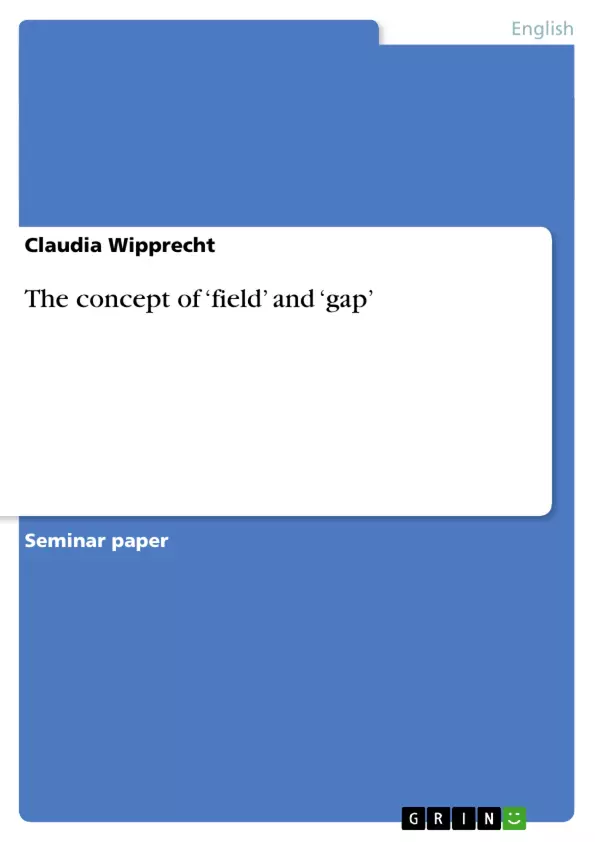The starting point of my research paper on field theory and gaps is the question: what are the different interpretations of ‘field’ in our language nowadays. I started with dictionaries and went on with encyclopedias.
According to the German dictionary “Duden” (Duden (2000: 370)) a field may be e.g. an electric field. This shows that this word may be lexical ambiguous. There can also be found some word combinations with ‘field’, e.g. cross-country, ‘ins Feld (in den Krieg) ziehen’ or field crop. This example shows that there is no one-to-one correspondence in English for ‘ins Feld ziehen’. A non-native speaker has to paraphrase this expression, e.g. ‘go to war’.
However, these notions are rather primary. In order to find a more precise kind of definition, I searched the “Wikipedia” (http://wikipedia.org/wiki/Feld (access: 2005-08-02, 12:14 MEZ)) and found a very detailed description of the term ‘field’: it can represent an acre (differentiated land area to grow agricultural crop), in sports the field to play on or a certain group of pursuers, in military history the theater of war, in general a specific field, in physics a certain position, in computer science a data structure, in cutting the term for a single picture, and in a specific area of heraldry the term for the parts of a crest.
By looking up ‘field’ in the online dictionary ‘Wiktionary’ (http://de.wiktionary.org/wiki/Feld (access: 2005-08-02, 20:22 MEZ)), I discovered nearly the same definition as in the “Wikipedia”, but there were two pieces of extra information about ‘field’: it may be a defined as an area on a sheet of paper, a board to play on, or a screen, but it can as well depict the world outside of a laboratory.
Inhaltsverzeichnis (Table of Contents)
- Structure
- 1. The term of FIELD in everyday language
- 2. FIELD Theories – general statements and presuppositions
- 2.1. Trier – Weisgerber
- 2.2. Lipka
- 2.3. Other theories
- 3. The concept of GAPS – general statements
- 3.1. Durell
- 3.2. Lehrer
- 4. Attempt of a FIELD analysis: semantic fields of ‘Basilikum’ and ‘basil’
Zielsetzung und Themenschwerpunkte (Objectives and Key Themes)
This research paper aims to explore the concept of "field" and "gap" in linguistics, analyzing different theories and applying them to a specific field of study. The paper examines the various interpretations of "field" in everyday language and contrasts it with the notion of linguistic fields. It investigates the concept of "gaps" in lexical fields and how they are defined and explained by different linguists. Finally, the paper provides an analysis of the semantic fields of 'Basilikum' and 'basil', highlighting the various types of relationships between words in these fields.
- Linguistic fields and their theoretical underpinnings
- The concept of "gaps" in lexical fields and their significance
- Comparison of different theoretical perspectives on field theory and gaps
- Application of theoretical frameworks to a specific semantic field analysis
- Interlingual differences in lexical structures and their implications for translation
Zusammenfassung der Kapitel (Chapter Summaries)
The first chapter of this paper explores the various interpretations of "field" in everyday language, examining dictionary definitions and encyclopedic descriptions of the term. It highlights the lexical ambiguity of the word "field" and its diverse meanings across different domains, setting the stage for understanding the concept in linguistics.
Chapter 2 delves into general statements and presuppositions of field theory. It examines the contributions of prominent linguists like Lehrer, Lipka, Trier, and Weisgerber, highlighting their different perspectives on the structure and organization of vocabulary. The chapter also discusses the importance of recognizing primary and secondary vocabulary, the role of speaker agreement in field analysis, and the challenges of comparing lexical sets across languages.
Chapter 3 focuses on the concept of "gaps" in lexical fields. It explores different types of gaps, including lexical gaps, specification gaps, and generalization gaps. The chapter examines the views of Durell and Lehrer on gaps, analyzing their arguments and illustrating their points with examples. The discussion touches upon the challenges of identifying and interpreting gaps, the role of context in determining lexical gaps, and the implications of gaps for interlingual comparison and translation.
The final chapter of the paper presents a comprehensive analysis of the semantic fields of 'Basilikum' and 'basil'. It identifies and describes various types of relationships between words in these fields, including hierarchical relationships, feature relationships, final relationships, local relations, equivalence relations, and relations of polarity. The chapter applies the principles and concepts discussed in previous chapters to analyze the specific field, highlighting the complexities and challenges of field analysis. The paper concludes by reflecting on the limitations of field theory and the ongoing debate surrounding the concept of gaps.
Schlüsselwörter (Keywords)
This paper focuses on the concepts of linguistic fields, lexical gaps, word-fields, semantic fields, semantic features, lexical ambiguity, lexical solidarities, interlingual differences, and the analysis of specific semantic fields. It examines the contributions of prominent linguists such as Trier, Weisgerber, Lipka, Lehrer, Durell, and Lutzeier, highlighting their different perspectives on the structure and organization of vocabulary.
- Citar trabajo
- Claudia Wipprecht (Autor), 2005, The concept of ‘field’ and ‘gap’, Múnich, GRIN Verlag, https://www.grin.com/document/75515



